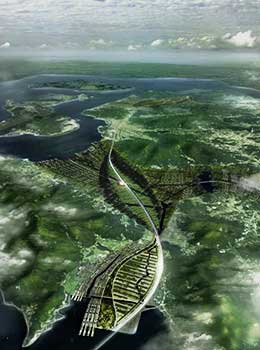Sep 2 2009
Foster and Partners, together with PHA and Mobility in Chain, has won an international competition to design the masterplan for the expansion of the Incheon Free Economic Zone, an extensive mixed-use scheme encompassing the islands of KangHwa and OnJin-gun, to the north west of Seoul. Conceived as a self-sufficient, sustainable development, the 300 square-kilometre masterplan will extend organically from a central transportation spine, creating a centre for green industry and serving a population that is expected to grow from 35,000 to 320,000 residents and commuters.

The scheme integrates a range of low to high-density mixed-use areas, connected by a Light Rapid Transit system and construction will be phased over 10 to 15 years. The area spans three main sites within the free trade zone – the north of KangHwa will be a centre of inter-Korean economic cooperation, taking advantage of its strategic location close to Incheon airport and North Korea, while the south of the island will be mixed-use, combining green technology industry with community, cultural and residential buildings.
It is envisaged that Incheon will become a national centre for sustainable industry: manufacturing photovoltaic panels and wind turbines, and developing new products and technology within a new research and development institute in the south of KangHwa. State-of-the-art measures employed within the masterplan include biomass energy generation, the use of hydrogen fuel cells and hydroponic roofs. OnJin-gun island will be transformed as a sustainable resort and the masterplan will eventually connect South to North Korea and the airport via the world’s longest bridge.
Taking agriculture as a central theme, the design utilises existing elements such as irrigation channels, green spaces and roads, while the arrangement of buildings within the masterplan follows the natural topology of the site, incorporating green roofs to further harmonise with the landscape. Like the veins of a leaf, the smaller roads and pedestrian avenues extend from the central transportation spine. The existing island is predominately agricultural so terraced farming, utilising the roofs of the industrial buildings, will replace any agriculture displaced by the development. There will be no structure above 50 metres, so the scheme will not extend into the foothills or mountain, thus preserving the rural landscape.
Grant Brooker, a design director at Foster + Partners, said: “Working at a very strategic level, we saw the masterplan as an opportunity to explore the sustainable potential of this extraordinary island, exploiting its pivotal position close to Seoul and its rugged landscape. We are delighted that the judges share our vision and, along with our collaborators at A+U, PHA and MIC, we hope to develop the project into the next stage.”